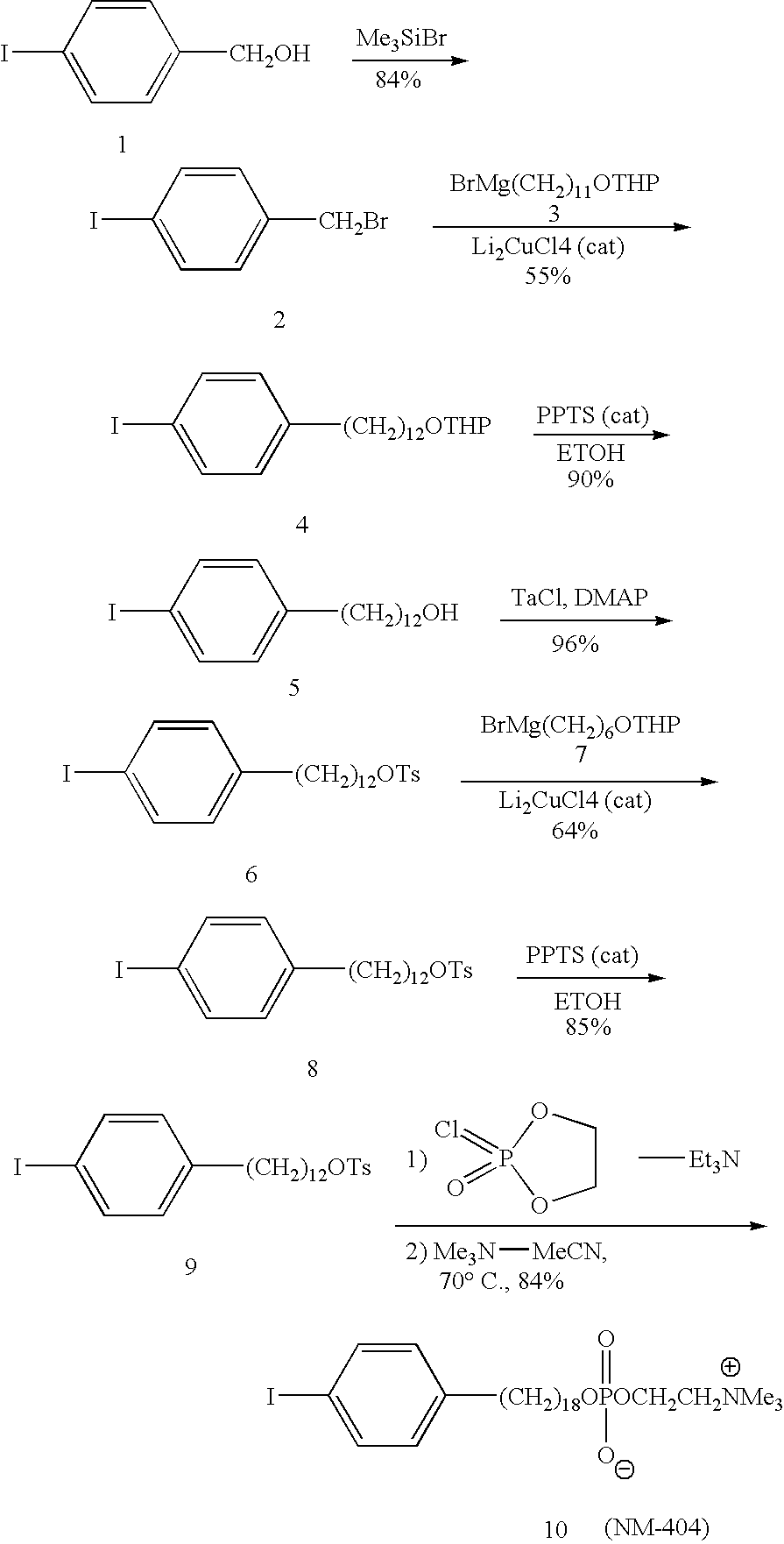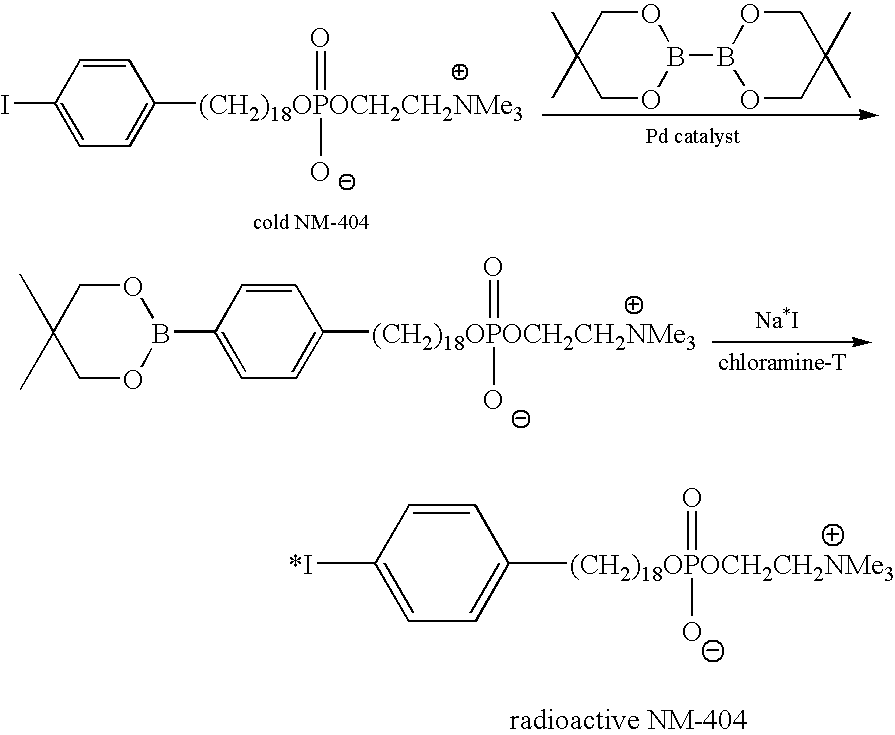Virtual colonoscopy with radiolabeled phospholipid ether analogs
a technology of phospholipid ether analogs and colonoscopy, which is applied in the field of virtual colonoscopy with radiolabeled phospholipid ether analogs, tumor diagnostic imaging and characterization, can solve the problems of difficult to obtain ct scan functional information during treatment and diagnosis, and the inability to characterize the space occupying lesions as polyps (adenomas) or adenocarcinomas (malignant), etc., to accurately determine if viabl
- Summary
- Abstract
- Description
- Claims
- Application Information
AI Technical Summary
Benefits of technology
Problems solved by technology
Method used
Image
Examples
example i
Synthesis, Radiolabeling, and Formulation of NM404
[0112] The synthetic approach was based on the copper-catalyzed cross-coupling reaction of Grignard reagents with alkyl tosylates or halides for the alkyl chain elongation (see the scheme below). The synthesis was started from p-iodobenzyl alcohol 1 which was converted into p-iodobenzyl bromide 2 by reaction with trimethylsilyl bromide. p-Iodobenzyl bromide 2 was further coupled with Grignard reagent 3 in the presence of Li2CuCl4 as a catalyst. 12-(p-Iodophenyl)dodecanol 5 obtained after deprotection of the first coupling product 4 was converted into tosylate 6. In the next step, tosylate 6 was coupled with Grignard reagent 7 containing 6 carbon atoms and this completed the chain elongation process. THP deprotection of 8 gave 18-(p-iodophenyl)octadecanol 9 which was converted into 10 (NM404) by two-step procedure as shown in the scheme.
[0113] Further, rapid high yield synthesis process for labeling NM404 with any isotope if iodine...
example 2
High Specific Activity Synthesis and Radiolabeling
[0129] In the synthesis of high specific activity NM-404, cold NM-404 is first coupled with bis-(neopentyl glycolato)diboron in the presence of Pd catalyst to form arylboronate ester. In the second step, the arylboronate ester is subjected to radioiodo-deboronation using radioactive sodium iodide and chloramine-T to obtain radioiodinated NM-404 with high specific activity.
[0130] Other esters of glycol esters of diboronic acid can also be used in the first reaction, for example: bis-(pinacolato)diboron and bis-(hexylene glycolato)diboron.
[0131] The important criterion of the high specific activity synthesis is that the final labeled compound, for example, 131I-NM404 and its precursor, the boronate compound must be easily separable by HPLC. This ensures that literally every molecule of NM404 that is isolated by HPLC is radiolabeled. Theoretical specific activity of the compound is about 2500curies / mmol. The existing isotope exchan...
example 3
Preclinical Studies with PLE Analogs
[0132] Phospholipid ethers can easily be labeled with iodine radioisotopes using an isotope exchange method described above. The iodophenyl phospholipid ether analogs are specifically designed so that the radioiodine affixed to each molecule is stable to facile in vivo deiodination. Over 20 radiolabeled PLE compounds were synthesized and tested in vitro and in vivo. Two of these, namely NM294 and NM324 [12-(3-iodophenyl)-dodecyl-phosphocholine], initially showed the most promise in animal tumor localization studies. These prototype compounds, labeled with 125I, selectively localized in tumors over time in the following animal tumor models; 1) Sprague-Dawley rat bearing Walker 256 carcinosarcoma; 2) Lewis rat bearing mammary tumor; 3) Copenhagen rat bearing Dunning R3327 prostate tumors; 4) Rabbits bearing Vx2 tumors; and 5) athymic mice-bearing human breast(HT39), small cell lung (NCI-69), colorectal (LS174T), ovarian (HTB77IP3), and melanoma tum...
PUM
 Login to View More
Login to View More Abstract
Description
Claims
Application Information
 Login to View More
Login to View More - R&D
- Intellectual Property
- Life Sciences
- Materials
- Tech Scout
- Unparalleled Data Quality
- Higher Quality Content
- 60% Fewer Hallucinations
Browse by: Latest US Patents, China's latest patents, Technical Efficacy Thesaurus, Application Domain, Technology Topic, Popular Technical Reports.
© 2025 PatSnap. All rights reserved.Legal|Privacy policy|Modern Slavery Act Transparency Statement|Sitemap|About US| Contact US: help@patsnap.com



